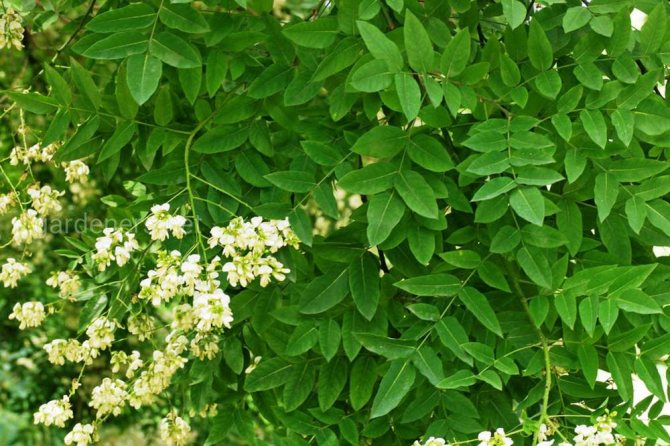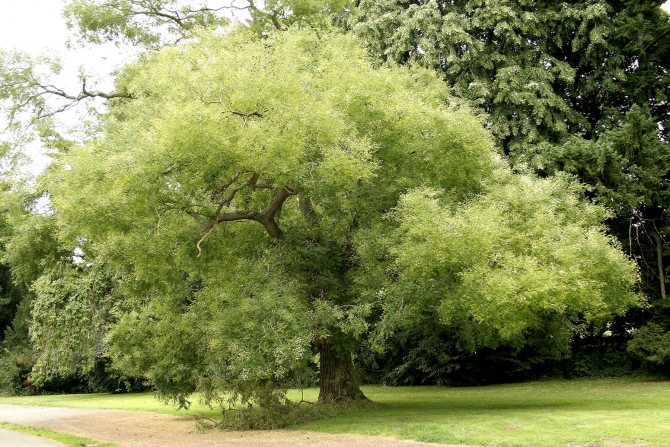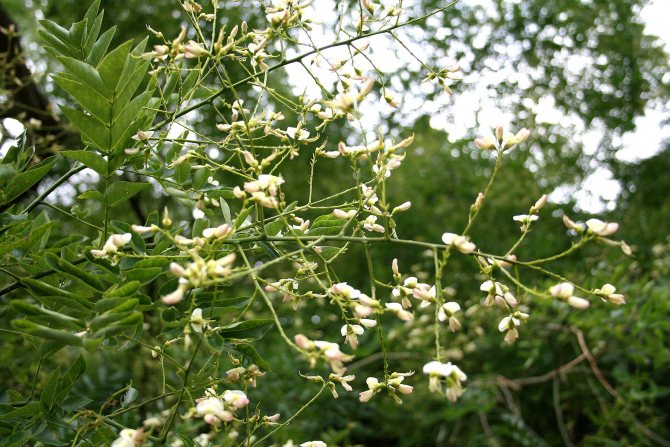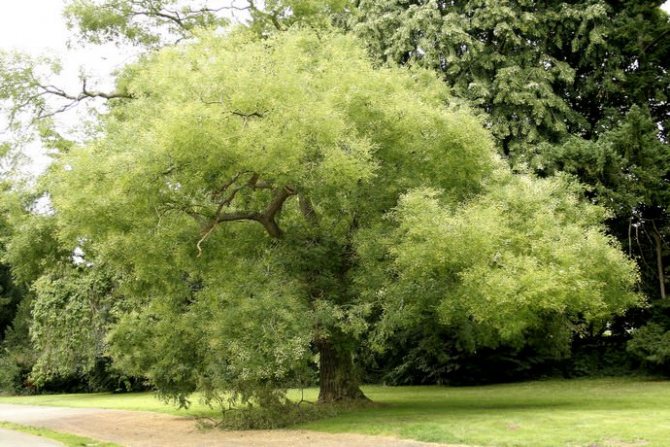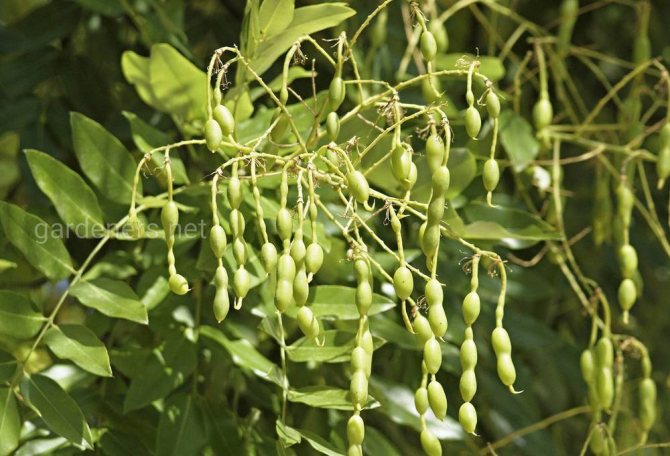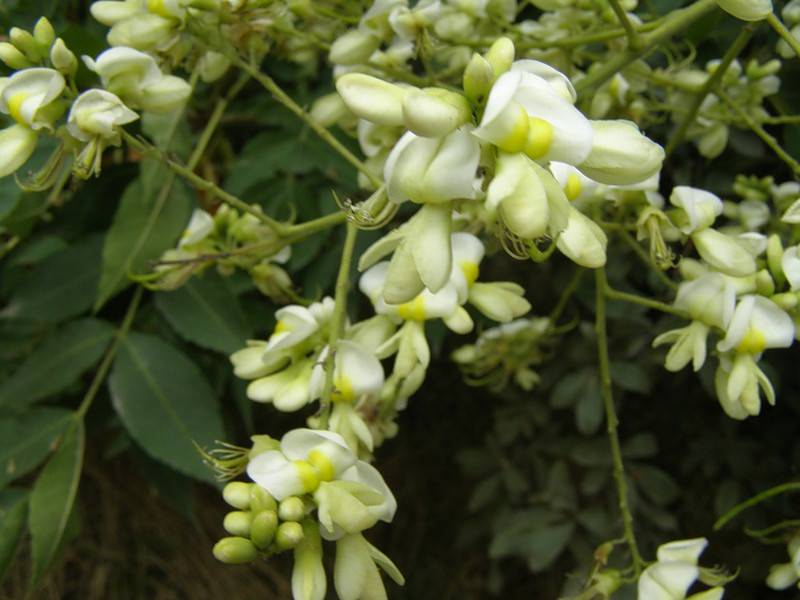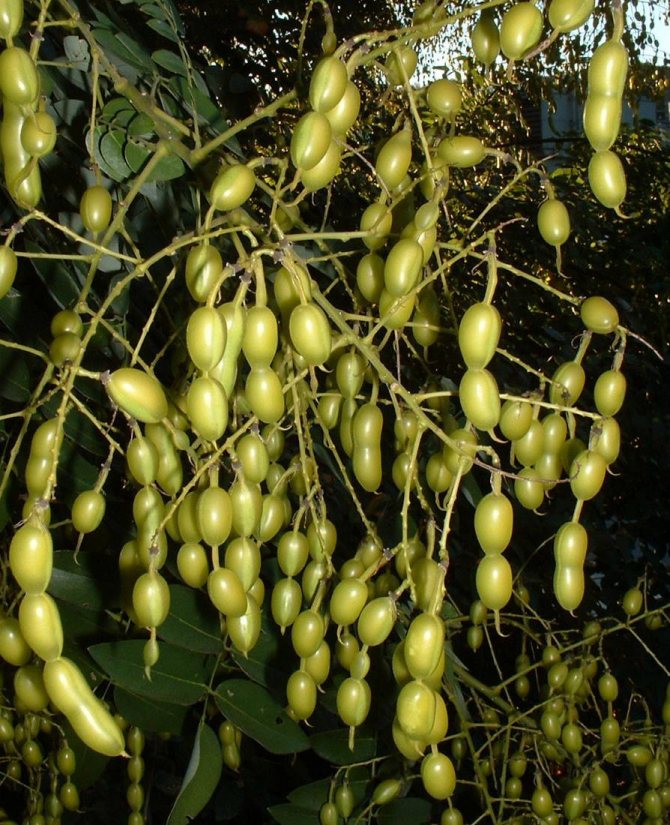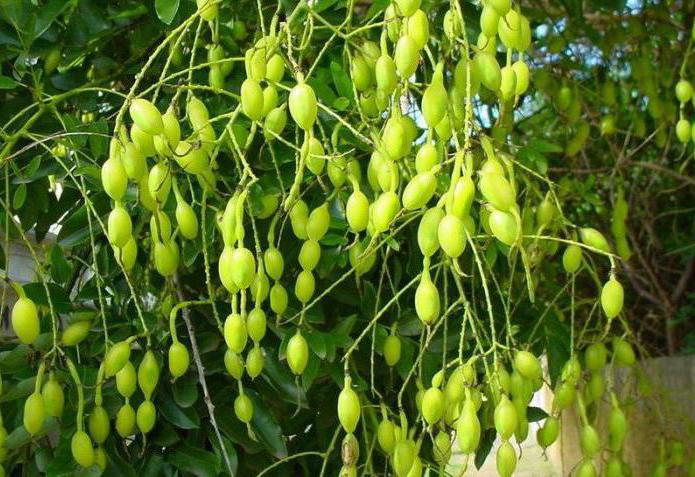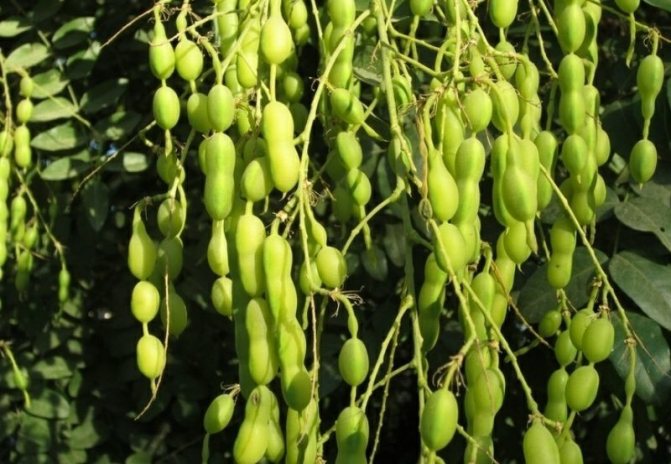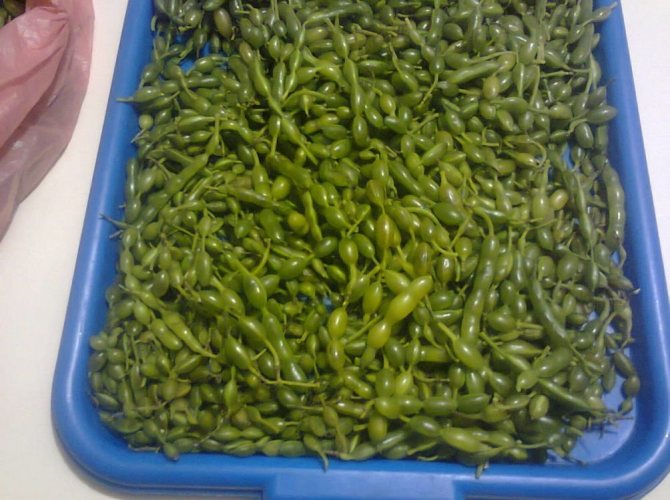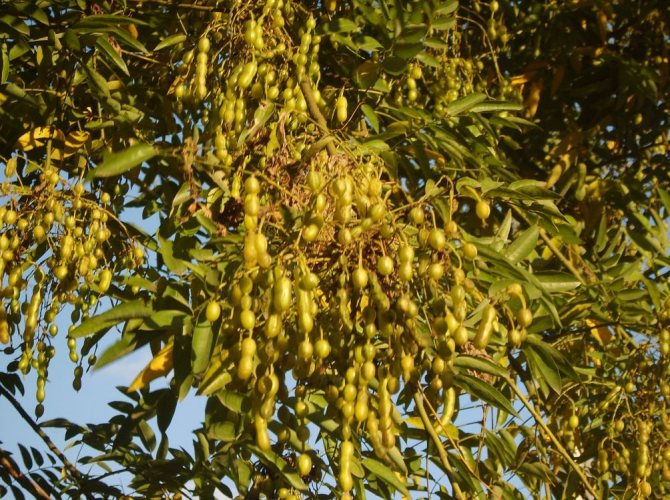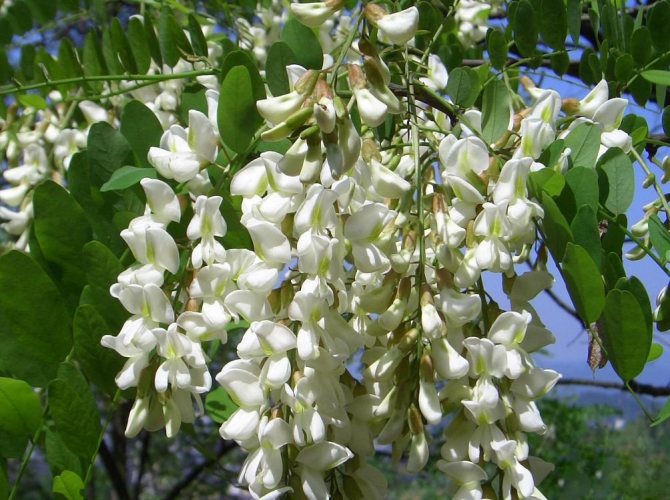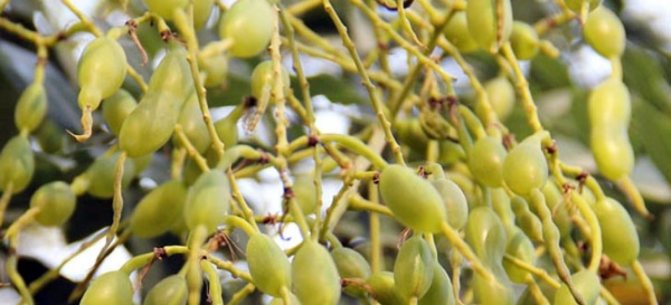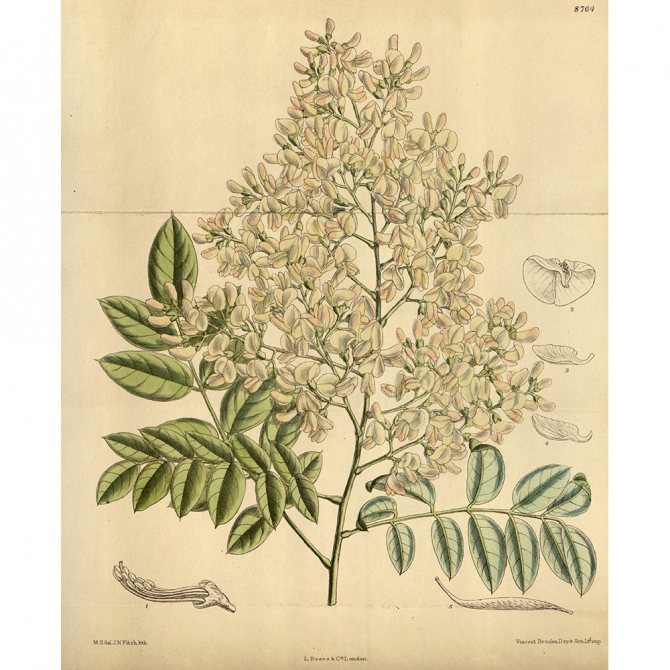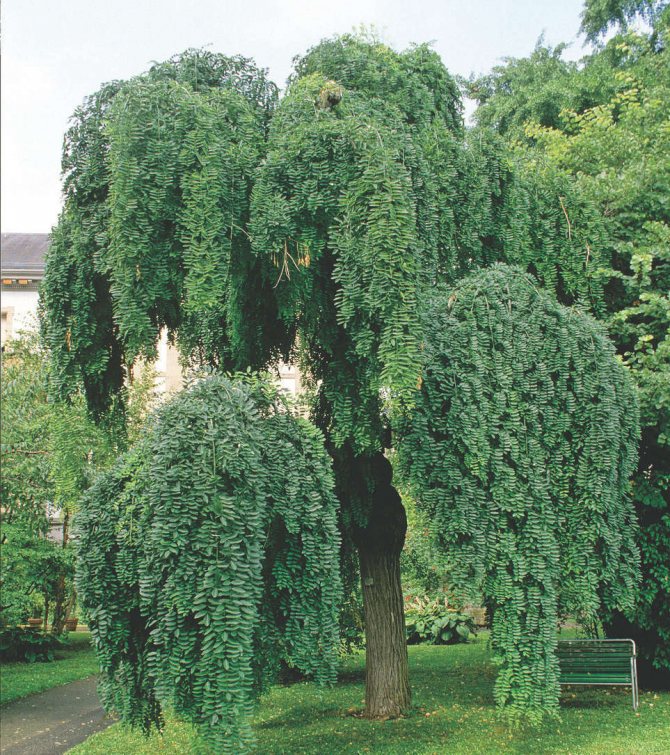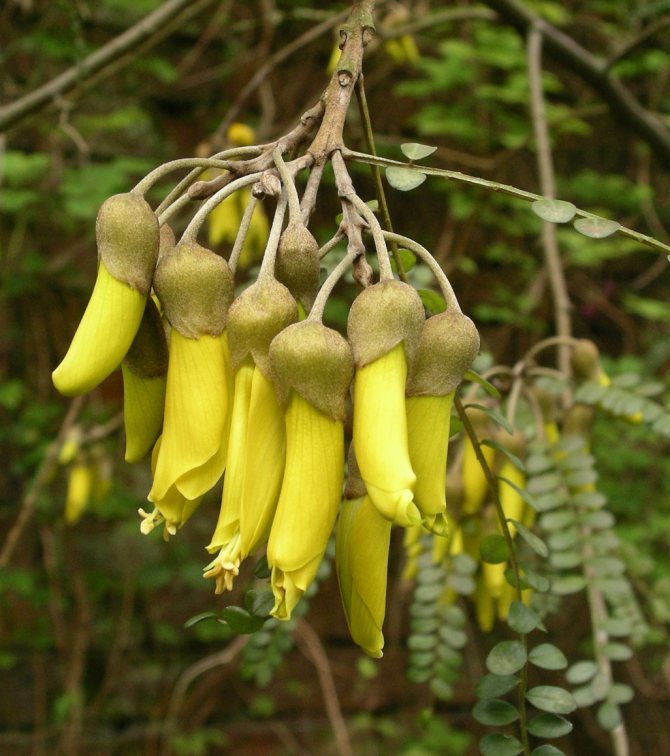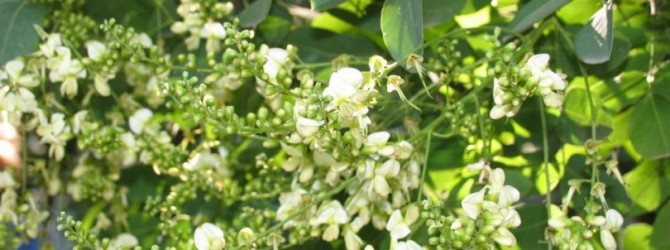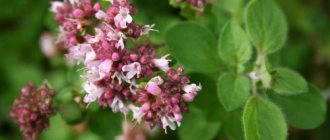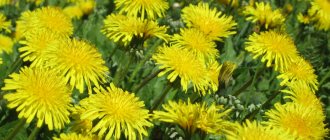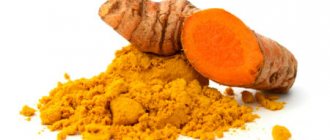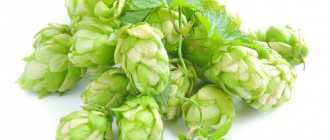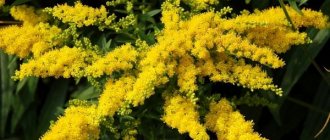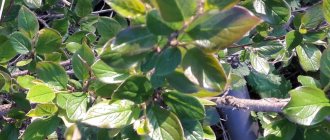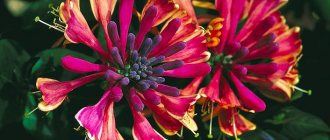The healing properties and contraindications of Japanese Sophora were first discovered by Chinese healers. The fruits of this tree have been successfully treated for cardiovascular diseases, used for the prevention of stroke. Sophora is a famous symbol of Beijing. In the countries of East Asia, the plant is called the "weeping tree" and is often grown for decorative purposes. Also, the plant is considered a valuable honey plant. Sophora honey, like decoctions, teas, tinctures, has healing properties: it cleans the walls of blood vessels, reduces pressure, prevents the development of atherosclerosis, thrombophlebitis, varicose veins.
Sophora Japanese description

Japanese Sophora is a deciduous tree that grows up to 20-25 m. It has a spherical, spreading or umbrella crown. The lower branches are located close enough to the ground. Covered with thick cracked bark. The leaves are smooth, bright green, arranged alternately on the branches. In the evening, the leaves roll up, and the next morning they open.
At the end of summer, flowering begins, and white-yellow double brushes appear, which gather in panicles hanging from the tips of the shoots. The average length of the inflorescences is about 35 cm. The peduncles, like the branches, look branched and contain keel-like delicate flowers. The size of the flowers is no more than 1 cm. The structure of the flower includes numerous petals and a drooping pedicel.
Sophora has melliferous properties. The honey collected by bees from flowers is considered curative and has a light amber tone. At the end of the pollination period, and this happens in October or early November, the plant bears fruit with juicy beans, hiding under the valves of thickened pods. The color of the pods is expressed in green-brown tones. By the end of ripening, the pods turn red. The beans stick firmly to the branches and can survive on the tree even in winter.
Places and rules for collecting medicinal raw materials
In Russia, the tree blooms quite late, from about mid-July to the end of August. The fruits ripen in October, and they need to be harvested earlier for the preparation of medicinal raw materials. When collecting, you need to pay attention to the shutters of the beans: they should be juicy and stand out in light green, but not red.
You need to start harvesting only in dry weather. It is best to start work no earlier than noon so that the dew on the foliage can dry out. Fruits need to be plucked or carefully cut in bunches with a secateurs. Then they are dried in a well-ventilated attic or in dryers while maintaining the temperature regime up to 45 degrees. The shelf life of finished raw materials is no more than a year.
Growing Japanese Sophora
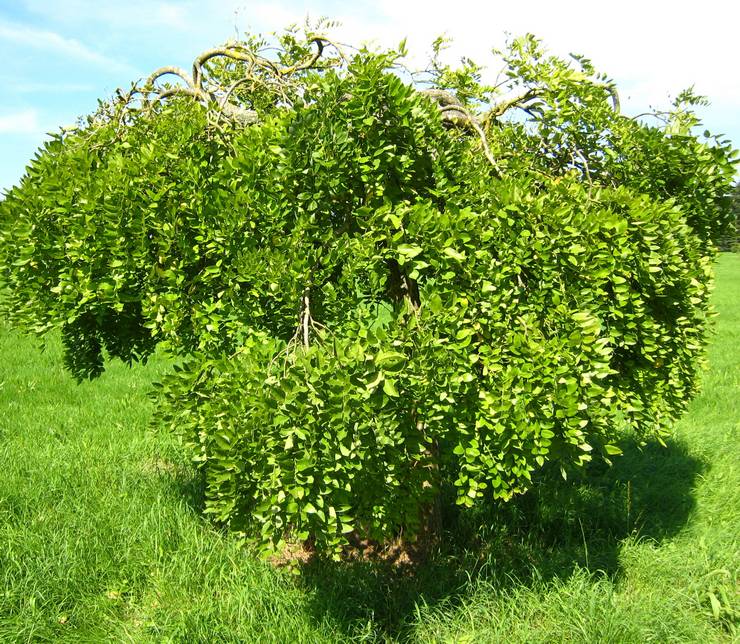

Cuttings or seeds are used to grow Sophora. Only fresh seeds are suitable as seed. To accelerate the emergence of seedlings, hot stratification is done, in which the seeds are pre-soaked for a couple of hours in boiling water, or scarification is arranged. We are talking about processing the skin with a nail file.
The material prepared in one way or another is placed in pots pre-filled with sand mixed with peat. The sowing depth is no more than 2-3 cm. After that, the plantings are sprayed with water and placed under a film.The growing process should take place at a temperature not lower than + 200C. Maintaining the temperature and access to light are important measures when growing Sophora. Seedling growth is slow, you should be patient. A pick is organized for grown plants that have acquired at least a couple of strong leaves. The roots extracted from the soil must be cut by a third. Only then are the seedlings transplanted into new pots.
The optimal time for cuttings is spring or summer. To prepare cuttings, the tops of the shoots are carefully cut off with a length of about 10 cm, keeping several healthy leaves. The place of the cut is required to be lubricated with "Kornevin" in order to stimulate the growth of seedlings. The planted cuttings are placed under plastic bottles with a cut out bottom. Seedlings need regular ventilation and moisture.
Contraindications to the use of Sophora
Sophora-based preparations must be used with great care, and only under the strict supervision of doctors. It is strongly not recommended to use such funds for pathologies of the liver and kidneys., as well as the presence of febrile diseases and hypotension. Do not use funds in the presence of severe atherosclerosis and angina pectoris. Absolute contraindications are pregnancy and lactation, as well as children under three years of age.
Poisoning provokes dizziness and residual vomiting, dryness on the mucous membranes, atony of the intestinal tract, abdominal pain, headaches, as well as severe psychomotor agitation and tachycardia. Artificial respiration should be considered as first aid for such poisoning, as well as gastric lavage with a weak pink solution based on potassium permanganate, after which you need to take several tablets of activated carbon.
Sophora planting


The cultivated species of Sophora, grown in the garden, easily overgrow with new branches and put deep rhizomes, but it is difficult to survive transplantation to a new place. It is recommended to replant young trees after a year. In perennial specimens, it is enough to replace only the topsoil. Since sophora has inherited traits from the legume family, it interacts with fungi that are in the ground. The result of symbiosis is the formation of not too voluminous whitish thickenings. Such a union "agreement" of two living organisms can be violated if, during transplantation, shake off the earth from the rhizome.
A favorable time for planting Sophora is the middle of winter, when the growing processes have not yet come out of the "hibernation" mode. Sophora is undemanding to the type of soil, however, the substrate must be air permeable and loose. Often, universal soil mixtures are used, consisting of garden soil and river sand. Having dug a hole, it is covered with a layer of drainage for better breathability.
Chemical composition
Any medicinal plant will envy the uniqueness and variety of the chemical composition of Styphnolobia. Useful components:
- Alkaloids: matrine, pachicarpin. They relieve pain, eliminate inflammation, and are endowed with a hypnotic, calming effect.
- Flavonoids: Quercetin, Rutin, Kaempferol, Genistein. Rutin (vitamin PP) has a rejuvenating, regenerating effect, normalizes metabolism, strengthens the walls of capillaries. Quercetin lowers blood pressure (blood pressure). Both substances have a calming and antispasmodic effect.
- Ascorbic acid. Increases blood clotting, improves immunity, strengthens the walls of blood vessels.
- Glycosides. They normalize the work of the cardiovascular and muscular systems.
- Organic acids. They relieve pain, inflammation, participate in tissue regeneration, kill pathogenic viruses, fungi, bacteria.
- Macro-, microelements: Ca, Fe, K, I, Mg, Zn, B.
- Fatty oils and linoleic acid used in cosmetology.
- Vitamin C.
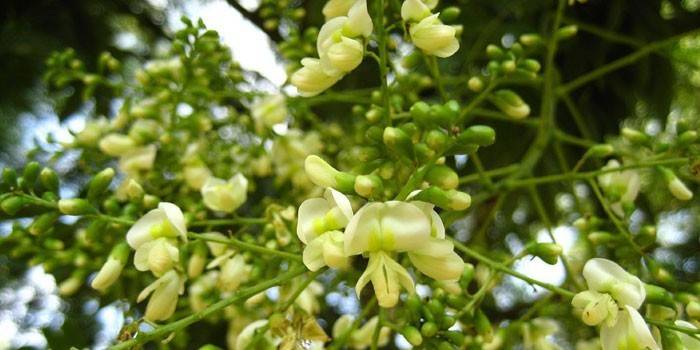

Sophora japonica care


Caring for Japanese Sophora does not cause many problems. Growing a tree is allowed to be organized either in the fresh air or under indoor conditions. Trees growing on the territory of Crimea, Sakhalin, the Caucasus and remote corners of southern Siberia transfer successful wintering outdoors. Indoor species require periodic pruning and containment of crown growth. Sophora will be an excellent gardener for office space and country houses. The tree is planted in a large tub and taken out for airing in the spring and summer months. It is important for proper development to maintain consistent and correct grooming.
Lighting
Sophora japonica overreacts to the lack of light. The tub with the plant is placed in a well-lit room, where the light during the day will touch the shoots and leaves for as long as possible. Direct sunlight is not dangerous for the tree, but in hot summer weather, it is better not to risk it and remove the plant further into the shade. During the short winter daylight hours, it is recommended to install additional lighting near the planting flowerpot.
Temperature
The adaptation process is fast enough. The plant can withstand even hot weather, but without ventilation indoors, foliage and branches will begin to fade. In winter, the tub with a tree is transferred to the cool. Sophora japonica, grown outdoors in the open air, can withstand short-term frosts, provided that it provides shelter around the trunk circle. In addition, with the arrival of winter, it is important to consider, as mentioned earlier, additional lighting when there is a lack of natural light.
Air humidity
In the natural environment, the tree chooses remote wastelands where it is easy to cope with low moisture levels. Branches and leaves do without spraying, but they need bathing and cleaning from accumulations of dust particles on their surface. It is especially important to wipe the ground parts of office gardeners.
Japanese Sophora is watered sparingly. A short-term drought will not harm her, but prolonged abstinence from water will be detrimental to the plant. Foliage may fall off due to lack of moisture. And, conversely, overflow of soil leads to decay of the root system and disruption of crown growth. Irrigation water is suitable for both settled and tap water with high hardness.
Top dressing
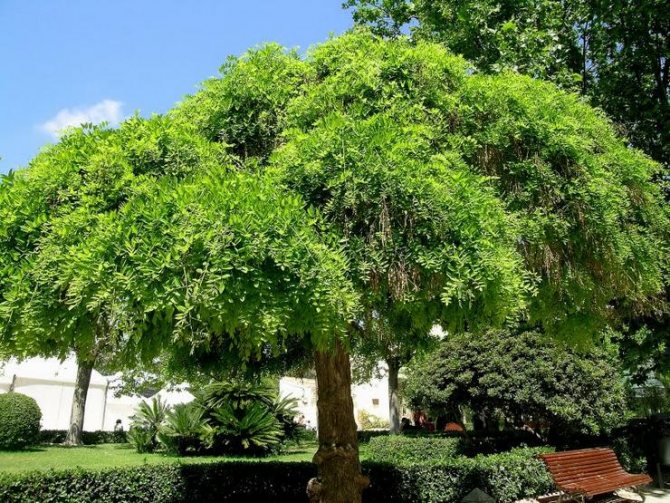

Since the end of winter, the tree is regularly fed. Every two weeks, the soil is enriched with solutions of mineral and organic fertilizers used in practical gardening for indoor flowering crops.
Pruning
The actively growing crown of the sophora requires pruning, since the annual growth of greenery often reaches up to 1.5 m. Shoots are periodically pinched for better branching and maintaining their shape. The most massive branches that form the skeleton of a tree cannot be cut without the help of a pruner.
Wintering
For outdoor plants, mulching the site is considered the only protection against unexpected frosts. The trunk circle is wrapped in peat or fallen leaves. Indoor Sophora trees tend to shed their leaves during the cool winter. The longer the daylight hours, the faster the buds will develop and the young foliage will grow. As soon as new growth appears, it is necessary to water the tree more abundantly and start applying the first top dressing.
Diseases and pests
If you do not adhere to the rules of care and transfuse the plant, the root system will be affected by rot. It is possible to stop putrefactive processes in tissues only through treatment with fungicidal preparations. There is also an infection of the ground part with a scale insect, aphids or moths. Pests can be stopped by insecticides.
Sophorin and other pharmaceutical preparations based on sophora
In the pharmacy, you can buy ready-made tinctures that can be drunk or applied externally, depending on the disease. but any extracts of Japanese Sophora are strictly forbidden to give to children under 12 years old. For adults, the dosage (when consumed internally) is from 10 drops to a teaspoon maximum 5 times a day. When using, allergic reactions may occur in the form of edema, itching or hives.
Japanese rutin, which is part of Sophora, is often used to create various medicines. One of the most popular is "Sophorin"... The instructions for this drug indicate that it can be used for topical treatment. This medicine will be an excellent choice for any skin lesions, including non-healing wounds caused by diabetes mellitus, as well as abscesses and ulcers.
Popular drugs are "Pahikarpin" and "Askorutin"... The latter are offered in pharmacological form only in the form of tablets, when "Pachikarpin" is also available in the form of injections. On sale you can find dry raw materials for the preparation of herbal tea and products in powder form.
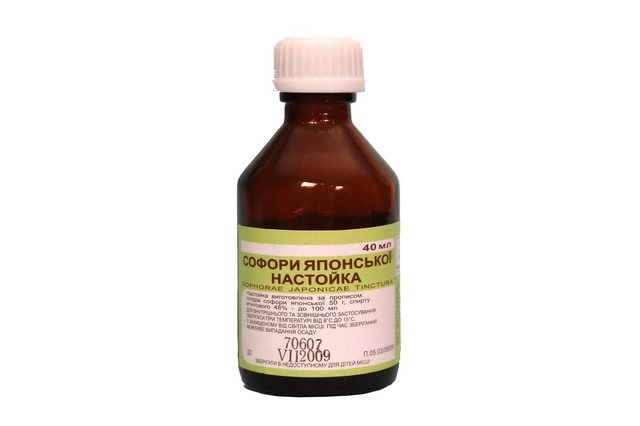

Tincture of Japanese Sophora can be bought at any pharmacy or prepared with your own hands.
Garden application of Sophora
Thanks to the wide spreading branches, decorated with lush and rich foliage, it is practical to install a gazebo under the sophora tree, arrange a resting place or organize a playground for children. The branches are very strong and can withstand a serious load, which allows you to fix the swing on them and make a real surprise for the children. The crown will be an excellent protection from the scorching sun rays, and the delicate sweetish aroma of inflorescences will create a cozy atmosphere. Sophora takes up a lot of space in the garden, so just one plant is enough. Alley plantings of this perennial are suitable for the park complex.
Habitat
Where does Japanese Sophora and its other species grow? You can meet the branched sophora tree in many European countries and not only. Places of growth are Asia, Altai, Caucasus, Ukraine, Western and Eastern Siberia and many other regions.
The favorite places of the tree are open sunny places, for example, meadows, valleys. You can see the Sophora on rocky slopes, on the shores of rivers and lakes.
In addition to the Japanese sophora, on the territory of the former CIS countries, you can also find such species as yellowing sophora and foxtail sophora. These plants also have beneficial properties for the body, due to the presence in their composition of a large amount of tannins, alkaloids, vitamins and trace elements. However, it is believed that the Crimean or Japanese species have the greatest benefit, see the photo of the plant in the article.
Sophora Japanese: benefits and harms
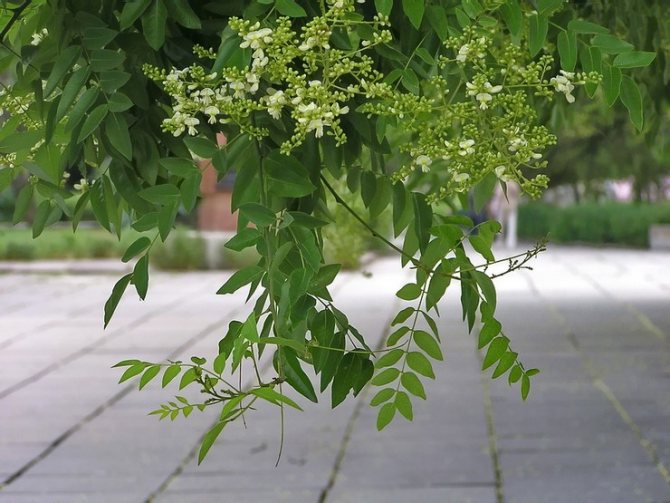

Healing properties
Both the ground parts and the roots of Japanese Sophora contain useful substances. First of all, we are talking about the flavonoid rutin, which strengthens the capillaries, reduces blood clotting and eliminates traces of edema. The alkaloid pachicarpin was also found in the tissues, which has a sedative effect. It stimulates the walls of the uterus and stabilizes the pressure. Found trace elements - potassium, boron, magnesium, zinc, iron renew the skin, remove toxins and give strength to the muscles. Glycosides expand the walls of blood vessels, remove phlegm and reduce excitability, and organic acids prevent the development of putrefactive processes in the stomach and the accumulation of toxins.
The use of Sophora has a positive effect on the performance of the circulatory system. Its substances act on the capillaries and reduce the risk of plaque formation in the lumen. Herbal raw materials are dried leaves, unripe fruits and newly emerged flowers. Drying is organized in a cool room with air access.Blanks are allowed to be used for no more than a year On their basis, herbal teas, decoctions and tinctures are made on alcohol.
Sophora's rutin acts as a sedative and helps to cope with a number of diseases. Lotions, compresses from dried raw materials relieve inflammation and heal wounds, and a few drops of alcohol tincture successfully cure toothache.
Sophora has a beneficial effect on the functioning of the brain, therefore, in official medicine, Sophora is used as a prophylactic agent for stroke.
Contraindications
There are almost no contraindications to the use of leaves, flowers and roots of Sophora, however, it is better for the category of allergy sufferers to refrain from such raw materials. Even if signs of a rash are not immediately detected, symptoms may appear much later.
Observing the correct dosage of Sophora preparations, the plant will not harm the body. It is not recommended to use medicinal drugs for pregnant women and young children. Adverse reactions to drugs often include indigestion, nausea and vomiting.
Deciduous Trees Garden: Trees and Shrubs
More useful - from what diseases?
Sophora flower and fruit extracts are most often interchangeable for medicinal purposes. But in each specific case, for the treatment of various diseases, there are certain rules and dosage regimens, which should be strictly adhered to.
For the treatment of blood vessels
The tincture is prepared according to the basic recipe. At one time, you need to stir half a teaspoon of alcohol extract in a glass of water. Drink daily, an hour and a half after meals. Take in courses for three weeks with weekly breaks. The tool seals the walls of blood vessels, serves as an effective prevention of varicose veins, thrombosis, strokes and heart attacks.
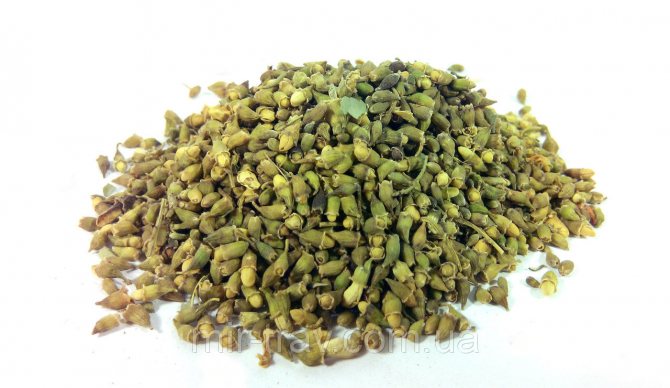

Dried Sophora fruits are used along with fresh
To eliminate the fragility of the capillaries, the use of an alcohol extract of sophora flowers and a rosehip decoction helps.
Application.
- Add 30 drops of Sophora flower tincture to 7 tablespoons of rosehip tea.
- The remedy should be taken three to four times a day before meals for a month.
Sophora the Japanese: clean vessels forever - video
With gastritis and stomach ulcers
The fruit tincture is used according to the usual scheme, in several courses. The treatment can be long, but the result is predictably good. Sophora regenerates the stomach lining, heals and renews, relieves inflammation. Along the way, the functioning of the entire gastrointestinal tract is normalized, including the problematic pancreas.
Be prepared for an exacerbation. Don't worry - this is a signal that the process is going well. Pain in mild forms of the disease may occur as early as the third day of treatment; with an old, neglected stomach ulcer - in the third week of procedures. There is no need to do anything drastic. This is the farewell tour of the disease, soon it will be gone forever.
With diabetes
The hypoglycemic abilities of Sophora have been successfully used in the treatment of type 2 diabetes mellitus. Mild forms of diabetes are completely cured, in difficult cases there is a significant improvement. To lower sugar, it is recommended to make a tincture according to a special recipe.
The tincture is prepared once a year, in autumn, from fresh, freshly harvested sophora pods. The juicy green beans are harvested on a sunny, dry day. Stock up so that the miraculous remedy will last until next season.


Tincture lowers blood sugar
Ingredients:
- fresh green sophora beans - 1 kilogram;
- alcohol diluted with water up to 56 degrees - 1 liter.
Cooking.
- Cut the pods into small pieces and crush in a mortar to chop the black seeds.
- Fold into a glass three-liter bottle, fill with diluted alcohol.
- Insist in the dark, shaking the bottle daily, for 12 days.
- Strain through three layers of cheesecloth.
Take a folk remedy in two treatment courses, in autumn and spring. The reception scheme is the same. The tincture should be drunk three times a day before meals. Start with ten drops, and add one drop to each subsequent dose. When a single dose reaches the volume of a teaspoon, do not change the rate and then drink a teaspoon for 24 days. Gradually, the sugar level will return to normal.
With mistletoe white
A tremendous rejuvenating and tonic effect for the body is provided by the use of tincture from a mixture of sophora and mistletoe. White mistletoe is unique in the world of plants; she does not live by herself, but at someone else's expense, parasitizing on the branches of old trees. An unusual lifestyle gives the white mistletoe and an exclusive set of properties.


Mistletoe settles in trees - that's where it is harvested
Ingredients:
- Sophora beans - 1 cup;
- white mistletoe - 1 glass;
- medical alcohol - 1 liter.
Cooking.
- Pass the sophora pods through a meat grinder.
- Chop the mistletoe into small pieces.
- Pour the mixture of mistletoe with sophora with alcohol.
- Put in a dark place for three weeks.
- Filter thoroughly.
Sunlight is detrimental to the beneficial properties of the drug, so it should be stored in a dark place. Take the tincture for six months. Daily dosage regimen: drink 30 drops per 50 grams of purified water three times a day half an hour before meals.
Treatment works well to heal
- diabetes;
- malignant neoplasms;
- liver and kidney disease;
- sinusitis;
- periodontal disease;
- varicose veins and thrombophlebitis;
- myoma;
- inflammatory diseases of the uterus and ovaries;
- mastopathy;
- lupus erythematosus;
- psoriasis;
- eczema;
- ulcerative colitis;
- gastritis, pancreatitis;
- hemorrhoids;
- prostatitis.
For hair treatment
When treating weak and brittle hair, Sophora gives fantastic results. Alcohol extract, diluted with water in a ratio of 1: 4, should be slightly warmed up and rubbed into the hair roots daily. Already after a month of regular use, hair loss stops, hair growth accelerates and the quality improves dramatically.


Sophora - balm for hair beauty
Application in cosmetology


the rich chemical composition of Sophora allows you to effectively care for the skin, giving it a healthy shine and beauty
The healing properties of Sophora are due to its composition:
- rutin;
- vitamin C;
- flavonoids;
- sofocarpine;
- pachikarpin.
In cosmetology, oil from plant seeds is also widely used. They are rich in fatty acids, resins, and various tannins. It is a natural antioxidant that strengthens blood vessels, including peripheral ones, protects against solar radiation.
But the main effect of Sophora in the field of cosmetology is brightening. The components of the plant interfere with the transport of melanin, provide anti-aging and anti-inflammatory effects. Sophora honey is a component of masks and creams. Has a rejuvenating, moisturizing effect, quickly heals wounds and damage to the skin.
The tool provides an antibacterial effect, promotes faster metabolism at the cellular level, prevents the formation of dandruff, tinctures and decoctions of Japanese Sophora buds for hair will strengthen them. The composition also has a protective and moisturizing effect on the skin, soothes it.
Sophora cosmetic ointment and other plant-based products are indicated for:
- hyperpigmentation;
- wilting and the appearance of wrinkles;
- rosacea;
- the appearance of age spots;
- inflammation of the skin.
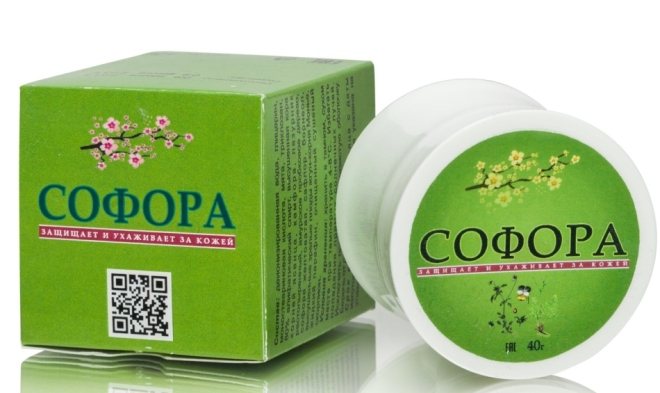

on the basis of sophora, they prepare a variety of cosmetic products for skin care
The product is used for skin whitening, wound healing. Lotions and creams based on the plant are suitable for oily and combination skin: the formulations tighten pores, regulate sebum production, and prevent the appearance of pathogens. Helps with seborrhea, neurodermatitis, itching of the scalp.
Beautiful representative of the plant world
The sophora plant is a species of the legume family, which includes numerous trees and shrubs.
If we talk about trees, then they often reach a height of fifteen to twenty-five meters and have an extensive spreading crown. In November, the leaves of Sophora, which are distinguished by their rich green color in summer, fall off, and the tree appears before frost in all its glory: a gracefully curved trunk, intricately spreading branches, cold-resistant abundant fruits.


It is noteworthy that the sophora plant bears fruit once every two years. The process of the appearance of these fruits is interesting and unusual.
In July and August, the original fragrant panicles, thirty-five centimeters long, of yellowish, pinkish or even purple flowers appear on the tree. After a while, fleshy fruits of a cylindrical shape, ranging in size from three to eight centimeters, are formed from these blooms, in which the seeds are located.
Other types of medicinal preparations
- Infusion. Pour fifteen grams of dry fruits with water (three hundred milliliters), insist for an hour, strain and add water to the required volume of 300 ml. Use as washings, compresses and dressings for skin conditions such as eczema, ulcers and others.
- Broth. Mix one tablespoon of flowers and fruits, pour a half-liter jar of boiling water and cook for five minutes. Let it brew for about an hour, strain and drink one hundred and fifty milligrams three times a day. It has a general strengthening effect, it is also used to normalize blood pressure, stop bleeding, purify the blood and relieve inflammation. Rubbing the decoction into the scalp helps to strengthen and grow hair.
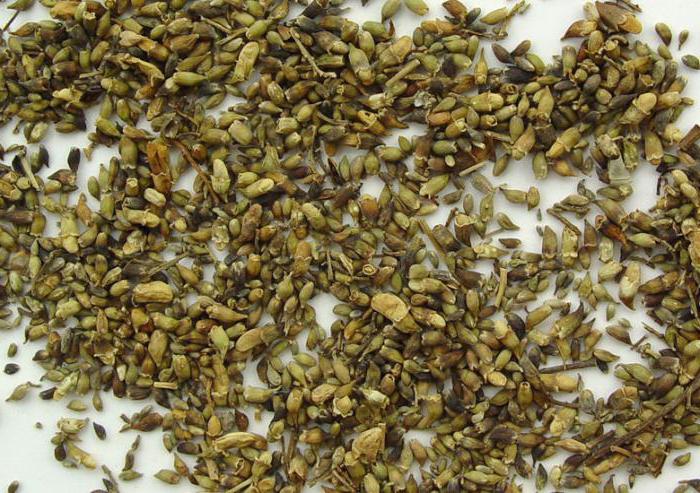

- Butter. Pour boiling water over dry fruits in a one-to-one ratio, wait an hour and grind the steamed raw materials into a gruel. Then add any oil (one to three ratio) and leave in the sun for three weeks. Strain. The oil prepared in this way can be used for nasal instillation with a runny nose and sinusitis (three times a day), as well as for wound healing.
- Powder. Powdered dry flowers take half a gram three times a day. Help with all the ailments listed above.
The healing properties of culture
Sophora is an amazing plant with a whole range of medicinal properties. The secret lies in the unique combination of biologically active substances: alkaloids and flavonoids. So, for example, vitamin P - rutin, the percentage of which in the flowers of the culture reaches 30%, includes almost four thousand bioflavonoids. These beneficial substances are similar in biological effect to the usual ascorbic acid, but in terms of effectiveness they surpass it at times. In addition, when combined with vitamin C, bioflavonoids exhibit powerful antioxidant effects.
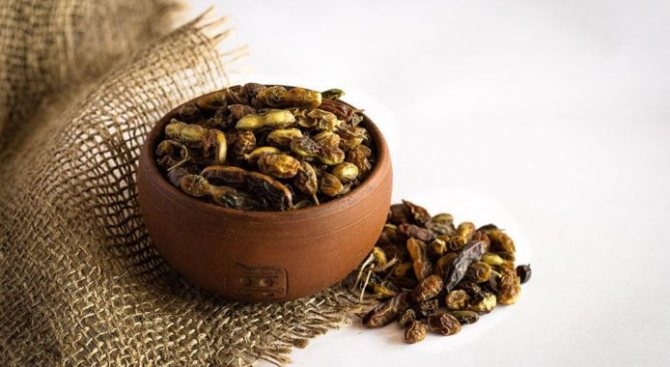

In general, rutin is an indispensable element that helps to improve the condition of the skin, as well as strengthen the walls of blood vessels and capillaries. It prevents thrombus formation, improves capillary permeability and slows down the aging process.
Other components of the bioactive complex are no less valuable for the body:
- Quercetin is a natural flavonoid with a regenerating effect. It stops inflammation and stimulates tissue repair, neutralizes the activity of free radicals and prevents cell mutation. The component stimulates the activity of immune cells, increasing the body's resistance to attacks by viruses, bacteria and various kinds of fungi.
- Kaempferol is a component that has a suppressive effect on cancer cells. It has a good preventive effect in case of the threat of diabetes and cardiovascular diseases.
- Pachikarpin is an alkaloid that has a urethrostimulating effect. An effective ganglion blocker weakens the motility of the gastrointestinal tract and partially inhibits the secretion of the glands.
Essential oils of Japanese Sophora are famous for their bactericidal properties.They demonstrate a therapeutic effect in the treatment of bronchial asthma and diseases of the musculoskeletal system. According to recent studies, Sophora essential oils have antifungal activity against Candida albicans 1029/13, Microsporum canis 1173 and Trichophyton rubrum 1220.
The seeds of the culture also contain fatty oils at a concentration of 10%. Only their chemical composition has been studied only superficially. It can be said for sure that the main components of the oil are: myristic, lauric, peanut and palmitic acids.
Stifnolobium - growing, planting, reproduction and care
Japanese Styphnolobium (Styphnolobium japonicum) is a perennial from the legume family. Under natural conditions, it successfully develops in China and Japan, this is the territory of its primary origin. This deciduous tree in natural conditions can develop up to 30 m in height. It has a wide spherical crown with a fairly developed root system.
In the first years of active vegetation, perennials give weak growth. The annual growth rate is at least 30 cm. After 30 years of active development, growth slows down significantly.
The perennial root system, together with certain bacteria, forms a symbiosis, as a result of which special growths (mycorrhiza) are formed on the roots, accumulating and producing natural nitrogen. Thanks to this property, Sophora can successfully develop on soils with a rather poor composition.
Leaves are odd-pinnate, with a pubescent shaft, oblong leaves, on short pubescent petioles.
The beautiful sophora is recognized as an excellent honey plant. The honey comes out in a light amber hue, which has healing effects. After the end of pollination in October or November, the fruits begin to ripen - juicy beans, the length of which can reach 3-8 cm in length. They are rounded pods, the skin of which is painted in a greenish-brown tone. Ripe beans hang from the branches throughout the winter.
Growing features
How to grow a lush Stifnolobium? In the common people, this perennial was named Sophora japonica. Perennial has certain requirements for the soil, it should be a loamy fertile soil with a pH level of 5.5-8.0.
The plant does not tolerate drought well, so it needs to provide abundant watering. Despite the fact that it loves an abundance of moisture, you should not allow it to stagnate for a long time in the soil. During a long absence of high-quality watering, an excellent sophora is able to dry out, the leaves may fall off. This state should not be allowed either.
A wonderful perennial is distinguished by shade tolerance, is resistant to urban conditions, salt resistance. Winter hardiness indicator: lush Styphnolobium is able to withstand frosts up to - 20 degrees. In the conditions of the Moscow region, it can freeze to the level of snow cover.
In central Russia, it needs additional shelter for successful wintering. The peak of decorativeness occurs during the flowering of a neat tree. It has excellent decorative properties in spring, autumn, summer, fruiting begins in September-October. The adorable Styphnolobium blooms in July August, in the conditions of the Moscow region it does not bloom and does not bear fruit. It produces yellowish-white flowers with a pleasant aroma.
Landing
Strong seedlings are planted in the spring. The primary planting site should be lighted, fertile. Green Stifnolobium develops successfully in loamy soils. The soil for the sophora should be breathable and moisture permeable. How to choose a sapling of an unpretentious Stifnolobium? To do this, you need to carefully examine the root system so that there is no damage, so that there are no dried shoots.
In the middle lane, an excellent sophora is rarely planted in open ground, since it is thermophilic.It is often grown as an unassuming houseplant. Once every 2 years, a room sophora is transplanted into a larger pot. Adult samples are not transplanted, they are limited only by changing the outer layer of the soil. Such an annual transplant is best done during the beginning of active plant growth - in January, February.
What should fertilize the soil for the successful growth of Japanese Sophora? As a rule, during the active growing season, an unassuming perennial is fed daily, it needs to be given organic matter, alternating it with complex mineral fertilizers.
Available breeding methods
Like any other plant, Japanese sophora can be propagated by ripe seeds, green strong cuttings, root cuttings. When propagating by mature seeds, it must be remembered that such samples need mandatory scarification. This is done in order to increase the germination of seeds, they are scalded with boiling water, poured with hot water. Stir the seeds continuously for 20 minutes.
After thorough drying, they are sown into the prepared soil. Seeds germinate for 2 months. Often this perennial is propagated by strong cuttings. For this purpose, cuttings up to 15 cm long are cut, treated with a special liquid for successful root formation, and planted in fertile soil in a warm room under glass or film.
Care features
Like any other plant, Sophora is annoyed by the following pests: annoying aphids, false shield, root rot and speckled moth. If the plant begins to actively shed its leaves, the color of the leaves begins to fade, this indicates the presence of a disease. Perennials are affected by root rot, which can be prevented by spraying with the help of special preparations. Other diseases do not strike a lush perennial.
How to care for a beautiful Sophora? Formative circumcision should be performed in summer and late winter. A perennial can be formed in the form of a standard tree. It is necessary to form a strong skeleton of the branches; for this purpose, lateral shoots are selected at an early age. In this case, it is important to preserve the central shoot as long as possible, if the top dies off, you can replace it. Formed trees require only minor pruning and do not tolerate anti-aging pruning.
Basic decorative forms
There are the following lovely varieties of Sophora, prized for their excellent decorative properties:
- Pendula is a weeping sophora variety;
- Columnaris - pyramidal plant shape;
- Violaceae - sophora that gives flowers with a purple hue;
- Pubescens - lush bushes with large leaves, slightly pubescent below, also produces purple flowers;
- albo-variegata - a rare form of perennial;
- Regent - this variety gives large leaves and flowers, has an increased growth rate, increased winter hardiness, blooms at the age of 8 years.
SENSATION!! The easiest way to save gas by 25% - 50% less ... Read more >>>
These are the most popular types of sophora that have found their application in landscape design. These varieties are small in size, which makes them convenient for use in the design of garden plots.
There are also the following types of Styphnolobium:
- Stifnolobium foxtail is a herbaceous perennial, all parts of which are covered with delicate hairs. The perennial can reach a height of 10-12 cm. This variety is often cultivated for the production of pachycarpine, which is used to improve muscle tone. It is often used for weak labor, it does not have any detrimental effect on the current level of blood pressure;
- Sophora is yellowish, some call it narrow-leaved sophora. It is a perennial that grows as a herbaceous shrub with an upright stem.The leaf plates have an ellipse-like shape with a rich green hue. For medical purposes, the rhizomes of this plant or seeds containing sufficient alkaloids, fatty acids, flavonoids are used. During the stabilization of nervous disorders, pain syndromes, insomnia, infusions based on this type of Sophora are used;
- Sophora thick-fruited is a herbaceous perennial with a more powerful and branched rhizome. The size of this variety ranges from 30 to 60 cm. It blooms in a cream shade with spike-shaped inflorescences. This variety is used for similar purposes as the previous type of Sophora;
- Sophora Japanese - Crimean variety, is a tree that successfully develops in the Caucasus, Crimea, Sakhalin and the Amur region. This variety has one significant disadvantage - the first flowering begins at the age of 30. This species tolerates drought well. It develops well in direct sunlight. Sophora blooms in small flowers with a wonderful aroma. This variety is used during skin diseases, burns, to restore the capillary system. It should be used with greater caution, only after the recommendation of the attending specialist.
Use in landscape design
The adorable sophora has long attracted many famous landscape designers. It is suitable for growing in group garden compositions, for solitary single plantings, with an ordinary planting, many decorators also do not do without the use of a sophora.
This beautiful perennial is successfully used for landscaping many garden plots and city alleys. He may feel comfortable with white acacia and ailant, but other stronger plants clog it.
Medicinal properties
Due to its rich chemical composition, lush Stifnolobium is known for its beneficial properties. Fresh sophora buds contain essential flavonoids, valuable tannins, polyphenols, organic acids. Ripe fruits contain 8 flavonoids, including rutin, kaempferol-3-sophoroside, fatty oil, valuable proteins, as well as genistein, important fatty acids, triterpenes.
As a medicinal plant, the well-known Styphnolobium is capable of providing wound healing, hemostatic, antioxidant, antipyretic, antihemorrhoidal action. Due to these properties, dried fruits and flowers of Sophora are actively used in folk medicine and pharmaceuticals. In dried form, finished raw materials are sold in a pharmacy.
Raw materials are also dried at home in a well-ventilated area. The shelf life of such blanks is 12 months. Ready infusions have a beneficial effect on blood vessels and capillaries. Sophora is able to cleanse blood vessels from cholesterol plaques, strengthen their walls and prevent fragility of small capillaries.
At the end of budding, during the beginning of the blooming of the petals at the base of the inflorescence, the sophora buds are harvested. They also collect unripe fruits, light green in color, the seeds of the perennial begin to harden. In May-June, the collection and harvesting of bark begins.
There are many different recipes using this famous perennial. It is used to treat the following diseases:
- Bleeding, trophic ulcers, severe varicose veins, gynecological bleeding, nosebleeds, redness of the eyes, dizziness, hypertension;
- Immature fruits are used for impotence, secondary hypogonadism;
- The dark bark is used to treat orchitis.
Like any medicinal plant, the beauty of Sophora has its own contraindications, so you should not self-medicate. During prolonged consumption, hypertensive patients may feel mild weakness or drowsiness, all this is associated with a decrease in blood pressure. People with severe allergic reactions should use such infusions with great care.
After a few days or weeks of regularly taking Sophora, they may develop allergic skin rashes. It is also unacceptable to treat pregnant and lactating women with infusions of Sophora. It is undesirable for children under 3 years old to use such infusions.
Sophora Korolkova is used as a tincture from fresh fruits, for treatment we use in the form of drops, 1 teaspoon 4-5 times a day. Japanese Sophora buds in Bulgaria are used in the form of a special healing powder.
Some scholars argue that the lush Stifnolobium is poisonous. But with strict adherence to dosages, there is no harm from infusions. As side effects from taking infusions of medicinal sophora, it is worth noting nausea, vomiting, diarrhea. If, after taking Sophora, symptoms appear that indicate a deterioration in well-being, you should immediately stop taking it, contact your doctor.
Compliance with all the rules and regulations can bring a beneficial effect, and the use of natural infusions of dried sophora will help increase muscle tone, strengthen the vascular system. During treatment with herbal infusions, it is worth remembering about contraindications and possible side effects.
Side effects
Allergic phenomena, diarrhea, nausea, vomiting are possible in some patients, which appear some time after the start of treatment, i.e. not right away. If the recommended doses are exceeded, blood pressure can rise greatly, so it is important to unconditionally follow the instructions.
When treating stomach pathologies in the first days, an exacerbation may develop in the form of pain in the epigastrium (if the ulcers are deep, the state of health may worsen on the 20th day of treatment). These pains indicate the regeneration of the uppermost layer of the gastric mucosa, do not require specific treatment - they just have to endure.
Sabuk Tatyana Leonidovna hygienist, epidemiologist
A bit of history
The healing properties of Japanese Sophora have been known since ancient times, although the first use of the flowers of the plant was as a dye. Then the tree was called "weeping" and planted next to the temples. It was believed that the tree not only helps in the treatment of ailments, but also knows how to read a person's mind and help make the right decision.
Eastern peoples worshiped the "weeping tree". The Chinese were convinced that fragrant flowers could prevent stroke, and were among the first to use preparations based on plant parts as an anti-inflammatory and pain reliever.
In 1747, Far Eastern botanists-breeders began the cultivation of the plant, mainly as an ornamental one. Already at the beginning of the 19th century, Styphnolobium was introduced to the Nikitsky Botanical Garden, located near Yalta, where the tree took root well and later spread throughout the entire Crimean peninsula, as well as throughout Ukraine (Kherson and Odessa regions). The plant has taken root well in the Krasnodar Territory, Priamurye, Primorye, Sakhalin, in the Transcaucasus, in Altai and in the Caucasus.
It is an excellent honey plant, decorates botanical gardens and cultural plantings in parks and squares. Sophora japonica preparations have found application in medicine and are effective in various, including the most serious, diseases.
Features of use as a cosmetic
- A decoction of Japanese Sophora is rubbed into the head to improve the condition of the hair follicles. The benefits are attributed to the high content of vitamin P - rutin. By regulating the work of the sebaceous glands, the decoction strengthens the hair roots, reduces hair loss.
- Infusion of Japanese Sophora can also be used for baldness.
Important! The infusion of Sophora should be diluted in a ratio of 1:10, since the pure tincture contains a high concentration of substances that, when in contact with the skin, can cause allergic reactions.
- Japanese Sophora lotion is used to rejuvenate and cleanse the skin, helps with seizures, rosacea and acne.
Recipe: pour 250g of pre-dried flowers with 0.5L of vodka. Insist for 14 days. Straining is optional. Wipe your face with lotion no more than 2 times a week. Take into account the ratio 1:10 when diluting with water.
- External use of tincture on Japanese sophora has a positive effect on the condition of both hair and skin. Moreover, it can be used to treat periodontitis.

